Kia Sorento PHEV review: a big, comfortable plug-in with seating for seven – but there’s a catch

Seven-seat plug-in hybrids (PHEVs) are few and far between. Normally, when a manufacturer adds a battery to its petrol SUV to turn it into a PHEV, it is located beneath the boot floor – right where the extra row of seats would usually fold down. So, more often than not, SUV PHEVs tend to be five-seat affairs.
Indeed, until now, there was only one option if you wanted a seven-seat PHEV, and it was an expensive one: the Volvo XC90 Recharge. Happily, there’s now another, in the form of this Kia Sorento PHEV – and it comes at a more attainable price.
We already like the latest iteration of Kia’s big, friendly giant. We’ve already tried the self-charging hybrid and diesel versions last year, and we found them to be pretty accomplished. So we have high hopes for the plug-in model Kia has just added to the range. Time to find out whether it lives up to them.
Pros
Full seven-seater with plenty of space for all
Bristling with equipment
Long warranty
Cons
No proper electric-only mode
Clunky to drive
Thumpy ride quality
Hybrid theory
The petrol engine in the plug-in Sorento is the same as you’ll find in the standard car; a 1.6-litre four-cylinder turbo that, on its own, produces a healthy 178bhp. But while in the non-plug-in hybrid, this is allied to a 1.49kWh battery and a 59bhp electric motor, the plug-in gets a 90bhp electric motor that’s fed by a 13.8kWh battery. The result is a combined maximum output of 261bhp, a surfeit of 35bhp and 62bhp over the hybrid and diesel versions respectively.
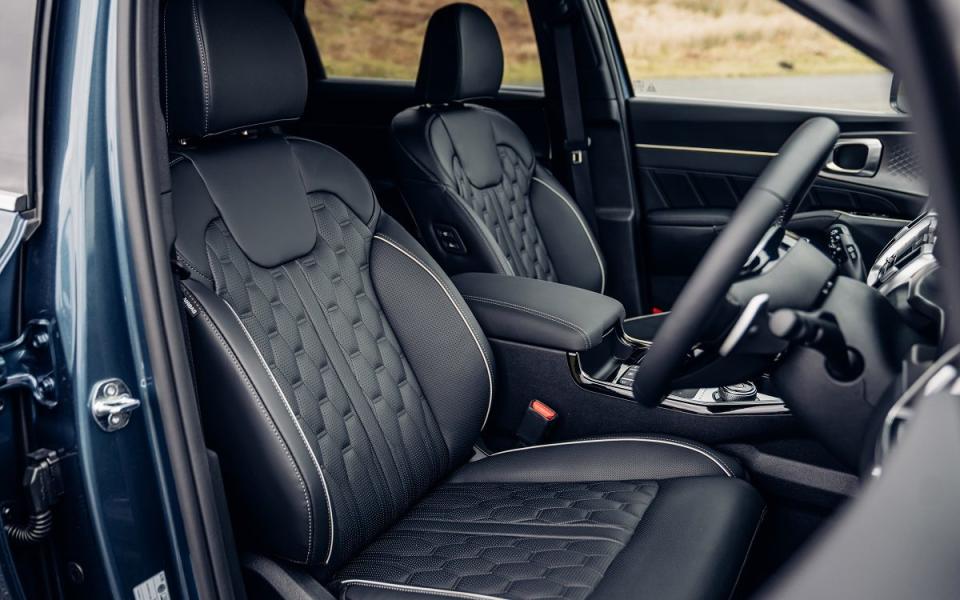
Kia also claims a 35-mile electric range for the Sorento PHEV, but a question mark hangs over this because it also admits you can’t actually get the Sorento to run on pure electric power.
Even in supposed “EV mode”, the Sorento’s petrol engine will kick in to aid with heating the car as soon as you’ve pressed the start button, and stays running for a while so it can warm up; if your journey is only 10 minutes or so, you can therefore find the petrol engine whirring away using fuel for the entirety of your trip.
What’s more, prod the throttle too hard and the petrol engine will kick in again to provide help with acceleration.
This presents an immediate problem. You see, if you’re buying a PHEV, you’ll probably want to use the electric powertrain for battery-only travel on short journeys, thus reducing your spend on fuel and helping to mitigate the considerable additional cost of a plug-in compared with a standard petrol, diesel or hybrid car.

The way the Sorento works means it’s impossible to do this, and that means for many buyers it’ll defeat the point of choosing a plug-in.
Equipment galore
But let’s put that rather glaring snag to one side for the moment and look at the rest of the car, for there’s much here to like. For example, the top-of-the-range 4 version we’ve got here is positively dripping with equipment; you get heated and ventilated front seats, a panoramic sunroof, a Bose sound system and a head-up display.
Even the entry-level 2 model gets plenty of toys, with 19-inch alloy wheels, a reversing camera, heated seats & steering wheel and adaptive cruise control all coming as standard. Between these two specifications sits the 3, which gets leather upholstery, ambient lighting, heated outer seats in the middle row, and a lovely widescreen sat-nav display.

This is given pride of place on the dashboard, which is slightly over-styled but finished in high quality materials; granted, the interior of the Sorento won’t give Land Rover any sleepless nights, but it’s a thoroughly pleasant place to be.
What’s more, crucially, you get proper buttons and dials for the climate control and other major functions, and that big screen is simplicity itself to find your way around, all of which comes as a blessed relief given the usability problems from which some modern cars’ interiors suffer.
The final frontier
This is a big car, and it feels it the minute you climb aboard. In fact, it feels positively gargantuan. In the front, for example, there’s plenty of room to stretch out, even for the broadest of frames, and no end of clever little cubbies in which to stash bits and pieces.
In the middle row, meanwhile, space is abundant, while even the rearmost seats – so often an afterthought in seven-seat SUVs – offer enough room for two adults to sit in relative comfort.
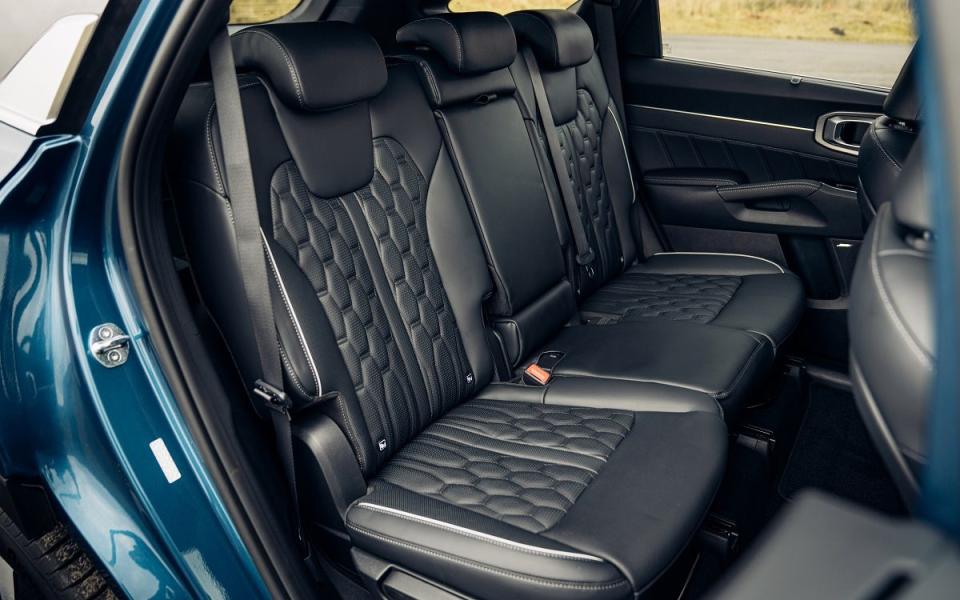
There are USB plugs and air-conditioning vents everywhere, too, so no passenger has to feel like they’re in cattle class; even in the third row, there are separate controls for the temperature and ventilation, as well as a cupholder and a storage bin for each seat. It’s gratifying to note you get these features as standard on every version of the Sorento, not just the top model.
It would be remiss of us not to note the fact that some other seven-seat SUVs – most notably the Peugeot 5008 – are a touch more versatile than the Sorento, with three individual seats in the middle row that slide forwards and backwards and fold separately. By contrast, the Sorento’s middle seat is attached to the passenger-side outer seat, creating a 60/40 split.
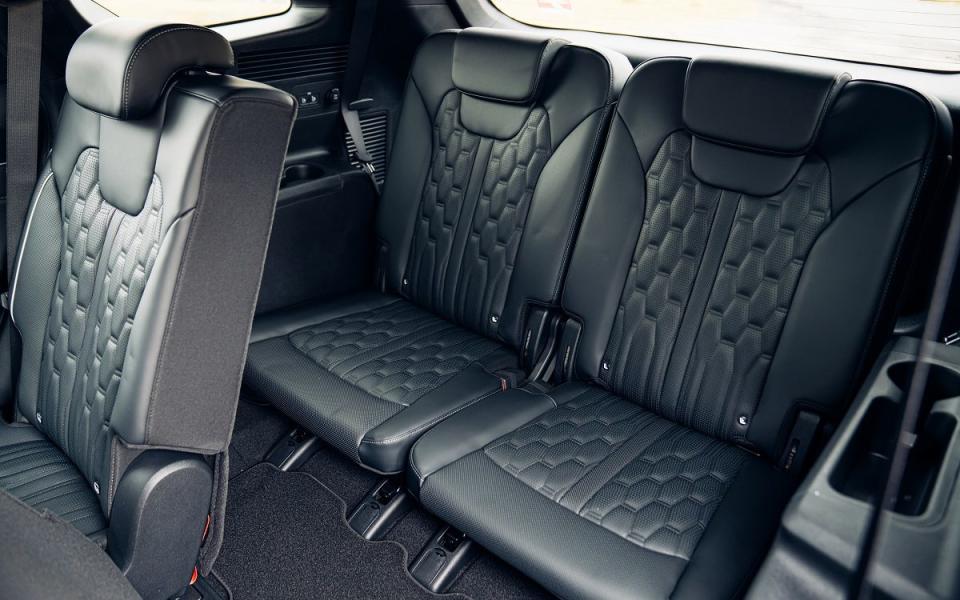
That said, the trade-off for this is that neither the 5008 nor the Sorento’s other seven-seat rivals can boast as much space in the rearmost row; more to the point, most don’t offer a plug-in version, and as we’ve already discussed, those that do usually sacrifice their third row of seats to make space.
Fold that third row down, meanwhile, and you get a sizeable and very usefully shaped boot, and beneath the floor of that there is, joy of joys, an actual spare wheel, rather than a can of tyre goo – a rare thing in this day and age, especially in a hybrid.

Expensive tastes
This Sorento is a top-of-the-range model with standard four-wheel drive, an automatic gearbox, and seven seats, but even then it’s hard to escape the notion that it’s a touch on the pricey side.
For example, a Land Rover Discovery Sport P300e in a similar specification will set you back around £2,000 less, and the same goes for the BMW X3 xDrive30e. Admittedly, both of these cars can only be had with five seats, and are a little smaller in stature and therefore less roomy than the Sorento, but even then they’re proper premium rivals with hybrid drivetrains that are at least as good if not better.
Official fuel consumption figures for PHEVs are, of course, a nonsense, but in the real world the Sorento will likely end up costing you more in fuel than most other plug-ins, purely by dint of the fact its petrol engine is running more of the time.
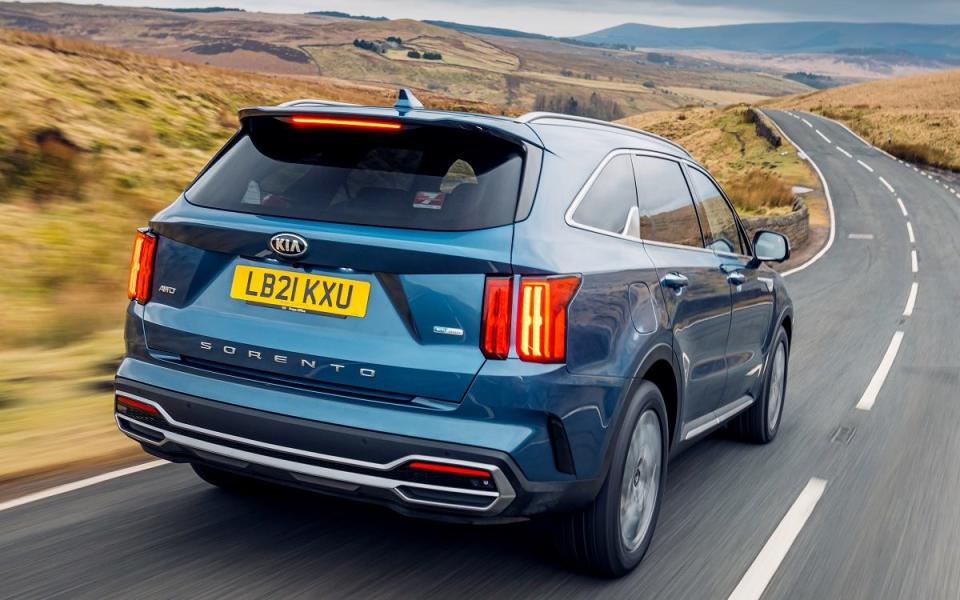
You’ll want to watch out for its depreciation, too; more specifically, it’s predicted to lose a greater proportion of its value over time than the standard hybrid model, and because it also costs more to start with, the hit you’ll take when the time comes to sell on could wipe out any savings you might make by choosing the plug-in version.
Of course, PHEVs make the most sense as company cars, when their low official CO2 figures result in a low tax liability. The Sorento is no exception; in fact, its CO2 emissions are lower even than most of its PHEV rivals’, and that’ll make it a particularly cost-effective choice as a company car, especially given the space and seating you get.
Gently does it
A bigger battery and a beefier motor were always going to have an effect on this car’s weight; indeed, the Sorento PHEV carries around 93kg more than the standard hybrid car, and 146kg more than the diesel. As you might expect, that extra heft takes its toll on the way the car drives.
For starters, despite its considerable power surfeit, the PHEV only hits 60mph 0.3 seconds faster than the hybrid – and that’ll equate to very little difference in the real world.
You feel it in corners, too, where the PHEV is a tad less willing to change direction. You’re quite aware of its mass trying to lean the car over; it’s reasonably well controlled to a point, but its desire to push on ahead instead of go the way you’re asking it to means you sometimes have to add a little more steering in a hurry, at which point the car lurches over on to its outside front wheel in a slightly ungainly way.
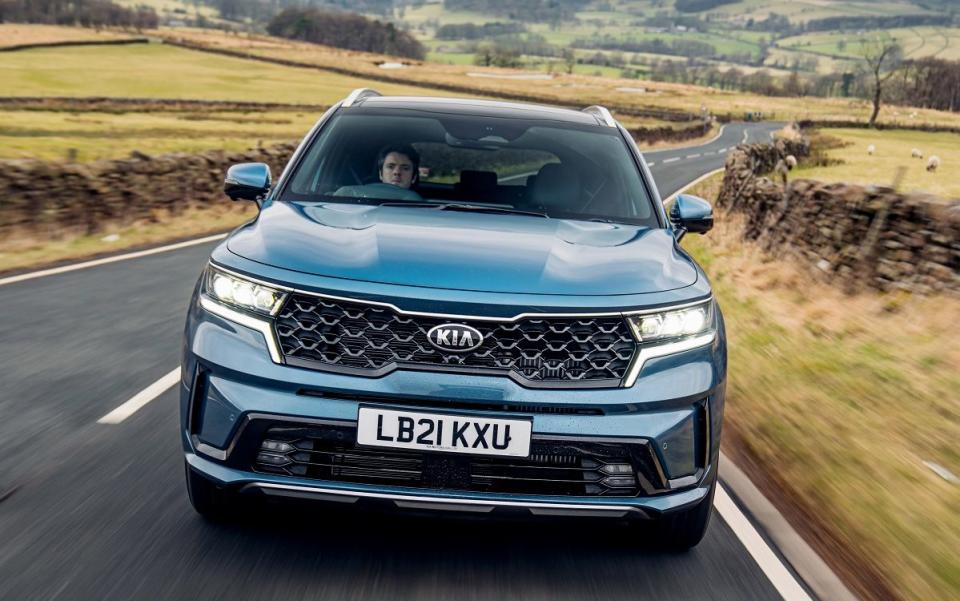
This is a big, seven-seat SUV, not a sports car, so if you’re not driving enthusiastically the Sorento makes a decent fist of lumbering around in an innocuous way, its steering responsive just off-centre and light enough that it’s easy around town.
Less forgivable is the way it responds to throttle inputs, however. Pulling away under electric power is fine, but as we’ve already discussed the Sorento only stays that way if you’re gentle – even when it’s supposed to be in EV mode.
Call for brisk acceleration, say if you’re going for a gap in traffic or pulling away at a roundabout, and there’s a delay while the car realises you require more urge than the electric motor can deliver.
It then has to fire up the petrol engine, which takes a second or so, and if you’re already on the move, it changes down a gear as well, which means you find yourself waiting for a couple of seconds for something to happen before the engine finally wakes up, protesting loudly as it does so, and the Sorento lunges forward awkwardly.

This, as you can imagine, is less than ideal, and far from the swift, smooth progress you might expect from a plug-in hybrid.
Then there’s the ride quality, which is reasonably settled and serene at speed but falls apart somewhat around town, where it thuds and thumps through sharper-edged ruts in a way that becomes rather wearing after a while. It’s not something you couldn’t live with, but there are more comfortable plug-in SUVs out there.
The Telegraph verdict
The trouble is, none of them comes with all those seats; that really is the Sorento PHEV’s trump card. If you’re after a plug-in company car with space for seven, it’s either this or the XC90, whose higher P11D value will make it far less affordable, and on that basis the Sorento does make a certain amount of sense.
If you’re buying privately, though, the Sorento PHEV is harder to recommend. It’s just a bit too lumpen to drive, and given you can’t actually run the PHEV on electricity alone, it’s difficult to see why you’d bother paying the extra for it, especially given you’ll probably lose any savings you make on fuel when the time comes to sell it.
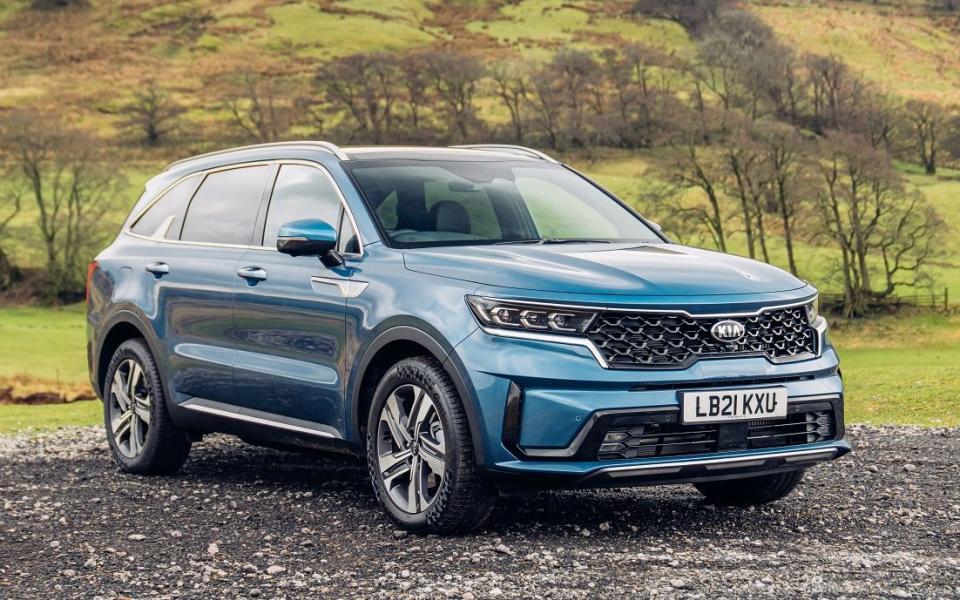
Which is a shame, because this really is a fantastically practical and, for the most part, comfortable car. It’s well equipped, too, even if it is rather pricey and, of course, Kia’s long warranty gives you peace of mind for a considerable time.
Happily, you get all of these good points with the standard hybrid version. And given that it’s both more affordable and better to drive than this PHEV, it’s very much the car you should buy instead.
Telegraph rating: Three stars out of five
The facts
On test: Kia Sorento 1.6 T-GDi PHEV 4
How much? £53,095 on the road
How fast? 119mph, 0-62mph in 8.4sec
How economical? 176.6mpg (WLTP Combined)
Engine/gerabox: 1,598xcc four-cylinder petrol engine, 261bhp (total combined maximum), six-speed automatic gearbox, four-wheel drive
The electric bits: AC electric motor with 13.8kWh battery, 3.3kW on-board charger, Type 2 charging socket
Electric range: 35 miles
CO2 emissions: 38g/km
VED: £0 first year, £335/year for five years thereafter, then £145
Warranty: 7 years / 100,000 miles (unlimited mileage in first three years)
Boot size: 604 litres
Spare wheel as standard: Yes
The rivals
Land Rover Discovery Sport P300e R-Dynamic HSE
305bhp, 143.1mpg, £51,620 on the road
The fact this lavishly equipped Disco Sport will actually cost you less than the Sorento shows just how pricey the Kia is. It only has five seats, but if you don’t need the extra row in the back this is a beautifully finished 4x4 whose driving experience is much more polished than the Sorento’s. Mind you, you don’t get such a long warranty – and given Land Rover’s reliability record, that might be a deal-breaker.
Volvo XC90 T8 Recharge Inscription Expression
401bhp, 100.9mpg, £65,540 on the road
Bigger, faster, and eminently more luxurious, the XC90 is in a different league to the Sorento. It also costs £12,000 more although, given what you’re getting, that doesn’t seem all that unreasonable. And if you want a plug-in that has seven seats, this is the only alternative to the Kia.
Toyota RAV4 Plug-In Dynamic Premium
306bhp, 282.4mpg, £50,895 on the road
This RAV4 plug-in doesn’t come cheap, but look at that power output. It is, as you might expect, comically quick, and also feels less clunky than the Sorento to drive. There’s no extra row of seats, but if you don’t need them, the super-low emissions figures make this an even cheaper company car proposition than the Kia.
For new and used buying guides, tips and expert advice, visit our Advice section, or sign up to our newsletter here
To talk all things motoring with the Telegraph Cars team join the Telegraph Motoring Club Facebook group here

 Yahoo News
Yahoo News 
